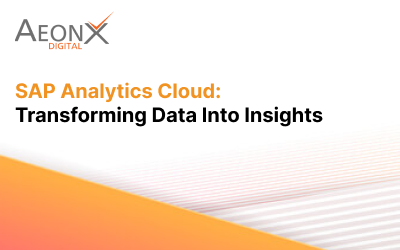SAP Analytics Cloud: Transforming Data into Insights
Data in the modern world is commonly described as a new form of oil.
However, as important as data is it cannot stand alone; it has to be refined, analyzed and converted into information.
That is where SAP Analytics Cloud – (SAC) comes into the picture.
SAC is an insightful all-in-one tool that allows businesses to use their data to track or make better decisions.
This article aims to discuss the purpose of SAC as a tool that assists organizations in turning data into value, the main functions of the tool, and the advantages it provides to businesses.
Understanding SAP Analytics Cloud
SAC is a cloud BIF now being used for analysis, planning and predictive analytics of data by organizations.
Among them are: it can interface with other sources of information so that users can be in a position to generate, display, evaluate as well as pass on sets of information in the smooth process.
SAP Strategic Analytics & Controls is a piece of the company’s overarching plan to empower companies and organizations to handle analytics, from the bottom to the top.
Major capabilities of SAP Analytics Cloud
Connectivity and Integration
SAC solution is well equipped with versatile and reliable connectivity solutions for businesses to connect to various sources containing SAP or non S/4 HANA, SAP cloud warehouses, on premise databases, and third-party solutions.
This guarantees that a unified view is provided to the users hence aiding them in their analysis and decision making process as well.
Data Preparation and Wrangling
It has flexible preparation features that enable users to pre-process their data before analyzing.
These tools include profiling tools, data wrangling tools, and blending tools, and help users in cleaning their data for analysis and integrating these into other sets for relevant analysis without having to necessarily be technical data scientists themselves.
Data Wrangling is an important concept, read this suggested article.
Visualization and Dashboards
SAC offers many choices of visualization of data in the form of charts, graphs, maps, and tables depending on the preference of the user in making beautiful and flashy dashboards.
These increase the usability of it by means of providing time-series & other types of info-graphics useful in coming to a particular decision.
Augmented Analytics and Machine Learning
SAC has machine learning and artificial intelligence embedded within it and enhanced complex dissection.
Each of such components allows for predictive analysis, pattern recognition, and results generation by the system.
The said features of the platform, the Smart Insights and Smart Discovery will reveal relationships that are not naturally derived from it and present the analysis of key metrics.
This article explains augmentation in depth. Click to read.
Collaborative Planning
SAC has features that include the planning and the budgeting tools where the teams are able to work on the financial and the operational plans.
It allows users to build and present their schedules, establish objectives, failure, and success that assist in the alignment of the organization.
Mobile Access and Reporting
Regarding the last mentioned aspect, the platform is portable, providing those using gadgets with access to the introduced information.
SAC also has powerful reporting features that can let its users easily create and disseminate reports to other people.
How does the sap analytics cloud work?
Unified Data Access
This is one of the primary functions of SAC that transforms raw data into useful information by giving consolidated access to different types of information.
This means that with the help of SAC, users can consolidate info stored in various systems, which eliminates silos and promotes data culture.
This single source of data entry is important for the creation of holistic information for optimal decision making.
Suggested reading about unified access.
Enhanced Quality
It is therefore important to ensure that quality is given as much consideration as is necessary in arriving at these insights as these will be very useful to inform action.
In addition, users can prepare it in SAC to guarantee the necessary quality such as clean, transform, and enrichment.
It enables the exclusion of drawbacks such as mistakes, but also heterogeneity and repetitive information, in this case providing a reliable material for further analysis.
Interactive Visualizations
This discourse therefore Young establishes that visualizations constitute a method of telling a story with the information.
The visualization facet enables the users of the software to build end user dashboards which are easy to interpret out of understandable data.
These types of charts assist the users to visualize such features as trends, patterns, and outliers for rapid decision making.
Predictive Analytics
For example, SAC’s operation and functionality support applying machine learning and artificial intelligence for performing preventive tactics.
SAC enables one to produce forecasts and see what might happen in the future, based on historical information.
Hence, this predictive capability causes industries to be more strategic as it enables them to predict trends, risks and thus take the most appropriate actions.
Read predictive Analytics in detail
Collaboration and Alignment
Decision making in an organization may involve parts of the organization such as departments and thus needs to be coordinated.
SAC supports this by keeping track of plans and performance indicators created and shared through the application’s collaborative planning functions.
This minimizes cases where people in the organization are working in different directions, or coming up with decisions from different analysis results.
Advantages associated with the use of SAP Analytics Cloud
Improved Decision-Making
The major advantage of SAC is that it helps drive better decisions.
Indeed, by presenting all of it in one place and ensuring the high quality, and the insights predictive, businesses can make the proper decisions.
This results in improved formation of business strategies, effective organizational performance and competitiveness in the market.
Increased Agility
Thus, in the midst of the constantly changing and heavily competitive business world, flexibility is key.
Flexibility of accessing and analyzing real-time info helps businesses to act prospectively to the changes in the market situation, customers’ preferences, and other drivers.
It also assists organizations to avoid competition and be in a position to solve problems and seize opportunities that come along the way.
Cost Savings
Managing and doing analysis and planning with the help of SAC may also result in considerable costs reduction.
It eliminated the dependence on numerous and diverse tools and saved time and efforts when it comes to pre-processing and analysis.
This is the case since it enables businesses to properly allocate their resources and work on targeted activities.
Scalability and Flexibility
In addition to that, due to the cloud-based infrastructure supported by SAC solution, the solution is scalable and flexible to accommodate various needs of different businesses.
The adaptability of the platform to the growth of data and changes in organizations’ needs means that organizations can continue leveraging as they expand.
SAP Analytics Cloud – Real Life Implementation
Retail Industry
Namely, in the retail industry, it is employed to assess clients’ information, inventory, and improve clients’ experiences.
SAC can be used by retailers in marketing to improve on the details of customer buying habits since these are personal, thus enhancing satisfaction.
Also, through business comprehension, SAC assists retailers in increasing stock turnover, minimizing stockouts, and enhancing the supply chain processes.
Manufacturing Sector
SAC is used in production management, quality, and supply chain management by manufacturing companies.
SAC empowers manufacturers to apply algorithm to real-time production data, determine where those processes are going wrong, and put right what needs to be corrected right away.
As it was established earlier, quality control and reducing downtime are some of the factors that have a direct relation with productivity and cost.
Financial Services
The commonly used sectors include the financial services industry where SAC is utilized in the aspects of risk management, fraud detection, and customer analytics.
SAC designed for financial institutions enables the institutions to study transactional structure and see suspicious activities potentially posing risks.
Furthermore, the perfect SAC assists the financial institutions to identify their customer’s behavior patterns thus facilitating the delivery of customer tailored products and services.
Healthcare
SAC in the healthcare industry has various applications in relation to the management of resources, value addition to patient care, as well as improvements of operations.
SAC empowers these healthcare providers to interpret results, examine trends and patterns in patients’ records and consequently design best solutions to help patients.
Also, for the health care organizations, staffing control in SAC provides the required number of staff, cuts down the operating expense and enhances the overall organizational effectiveness.
Public Sector
In the public sector, SAC is employed in the areas of service delivery, increased transparency and efficiency of resources.
The Government agencies for instance can utilize the SAC to synthesize available info with regards to the public services and in turn determine where changes can be made to the enhancement of the provision of the services.
Also, SAC assists the government agencies in increasing the level of transparency since the citizens get to view the insights.
Challenges and Considerations
While SAP Analytics Cloud offers numerous benefits, organizations should be aware of potential challenges and considerations when implementing the platform
Data Integration
Intersecting of data from a variety of sources may prove to be cumbersome and extremely time consuming.
Tomorrow’s organization must recognize a well-planned and sound integration to enhance the smooth flow and availability of data.
Data Security
Security of data is always a paramount aspect, being that this is a cloud-based software.
User Adoption
SAC can only be fully utilized if people take it up and use it in their work practices.
As it has been seen, organizations hence require to also spend time and money on training and change management processes so as to get the users on board and be in a position to capitalize on this functionality.
Customization and Scalability
Thus, organizations will appreciate that, although scalability is provided through the use of the SAC, the flexibility of the platform has to be adjusted to match the enterprise’s requirements as per its line of business.
It can depend on elements that may need more features to be added and hence more investment on customization and configuration may be needed.
Future trends of SAP Analytics Cloud
As technology continues to evolve, several trends are likely to shape the future of SAC and the broader analytics landscape.
Artificial Intelligence and Machine Learning
The use of AI and machine learning to analytics tools will remain popular, improving the depth and velocity of the business predictions and automations.
That will help organizations to produce better and more sophisticated analysis and make right decisions.
Augmented Analytics
Augmented analytics will continue to increase as the integration of artificial intelligence and human intelligence.
The application of this approach will allow the users to work with data in a more natural and organic way and reveal things that weren’t visible before.
Embedded Analytics
The tendency to increase the usage of embedded analytics solutions in which analytics functionality is built into business applications will continue to grow.
This will provide the users with a chance to come across the knowledge within the dynamics of their work environments increasing work-flow and decision making.
Data Governance and Privacy
By nature, governance and privacy of the data will stay important, as data volumes grow and regulation becomes stricter.
Companies will have to apply sound architectures of mastering, monitoring, and directing data to meet information quality, adherence to legal and/or business rules, and protection standards.
Cloud Adoption
This trend will continue for various organizations since they are in search of analytic solutions that are scalable, flexible, and that can save costs by going for cloud solutions.
Cloud technology will help organizations apply sophisticated analytical solutions while avoiding the necessity to make tremendous investments in corresponding tools.
Real-Time Analytics
The application of real-time analytics is growing in significance because firms are attempting to make decisions faster.
The technical characteristic of analyzing data in its real-time makes the organizations able to adapt to conditions, customers’ behaviors, and trends more frequently and promptly.
Regular updates and improvements of the system will be made to focus on the real-time data processing for providing the clients with the accurate, fresh, and more actionable insights.
Suggested reading What is real time analytics.
Natural Language Processing (NLP)
Applied to the present scenario, Natural Language Processing and other data analysis tools are changing the way users interface with the information.
From this feature, NLP helps to advance the capabilities of analytics by making it possible for users to conceive and employ queries using a simpler process which does not necessarily require technical knowledge.
SAP Analytics Cloud is expected to offer more of such NLP items, where users can type in questions and be answered in conversational form thus bringing data analysis to all levels of the organization.
Read this article to know more about NLP.
Advanced Visualization Techniques
Complex visualization as a subfield will saturate, which means that new and more developed methods of representing it will be introduced.
Strategic technologies like interactive reality data, and holographic data will extend the capabilities for users to interact with it in new concepts like the VR and AR approaches.
These advanced visualization techniques will probably be implemented in the SAP Analytics Cloud tool set as it assists users in understanding aspects of big data.
Integration of Things in the Internet of Things (IoT)
The Internet of Things (IoT) for example is creating big data from devices and sensors attached to the net.
By connecting the IoT sources to SAP Analytics Cloud businesses will be able to make better use of this data, which has the potential of resulting in better performing manufacturing lines, predictive maintenance, and better satisfaction of the customers.
The integration of IoT data analysis with other business data will also be a way to obtain a more profound idea of the business.
Blockchain for Data Integrity
Blockchain technology is gaining traction for its ability to provide secure and transparent data transactions. Integrating blockchain with SAP Analytics Cloud can enhance data integrity, ensuring that data is accurate, secure, and tamper-proof.
This is particularly important for industries such as finance, healthcare, and supply chain management, where data integrity and transparency are critical.
Conclusion
SAP Analytics Cloud is a versatile solution that provides the small and medium sized businesses with everything they need in the analytical sphere.
SAC enables organizations to make right decisions by providing a single point of access to info, improving its quality, allowing users to explore and analyze it interactively, and by providing predictive analytical tools and features that enable collaborative planning.
The advantages that are related to SAP Analytics Cloud are the better decision-making, flexibility, cost-efficiency, integration, and adaptability.
Based on current trends the future roadmap for SAP Analytics Cloud and further analytics developments includes trends like Artificial Intelligence and machine learning, augmented analytics, embedded analytics, analytics governance and protection, and the increasing focus on the Cloud environment.
In turn, businesses are able to properly utilize these trends and the functionality of SAP Analytics Cloud to maximize the value of it required for positive business results.
Check out our AeonX business solutions to streamline your business’s effectiveness.
Frequently Asked Questions
What is SAP Analytics Cloud or popularly known as SAC?
SAP Analytics Cloud is a cloud-based BI solution to include BI, planning and predictive analytics in one integrated solution.
It makes it possible to present, analyze and share information to support decision making within the business.
For which roles would the usage of SAP Analytics Cloud be useful and who could take advantage of it?
SAC is aimed at different users starting from analysts and ending with business users and plans and executives across industries like retail, manufacturing, financial and professional services, healthcare, and public sector.
Which aspects of SAP Analytics Cloud are worth connecting and using?
- Preparation and wrangling
- Visualization and dashboards
- Science, Augmented analytics and machine learning
- Collaborative planning and budgeting
- Mobile access and reporting
Is it possible to build your own widgets in SAP Analytics Cloud?
Yes, SAP Analytics Cloud provides an effective way to build interactive and configurable dashboards, which are based on charts, graphs, maps or tables.
It means that identified dashboards could be adjusted according to certain business requirements and be informative.
Author Details
Vicky Gandhi
Vicky Gandhi, an SAP FICO Consultant and Project Manager with 16 years of experience, combines 8 years in SAP implementations and 8 years in finance. Currently leading the FI Team at AeonX Digital Technology Ltd., he has a proven track record of driving innovative and efficient SAP projects across industries.
Sunil Kumar Dash
Sunil Kumar Dash, with 8 years of experience in business intelligence, planning, and predictive analytics, specializes in SAP Analytics Cloud (SAC) solutions, including dashboards, data models, and planning tools. Proficient in integrating SAC with platforms like SAP HANA and S/4HANA, he delivers practical, high-performing analytics solutions across industries, focusing on efficiency, user training, and post-implementation support.



